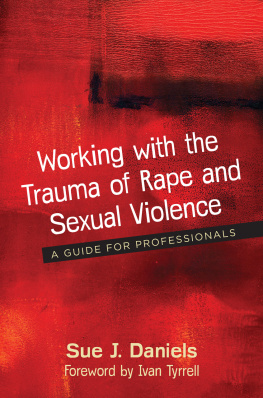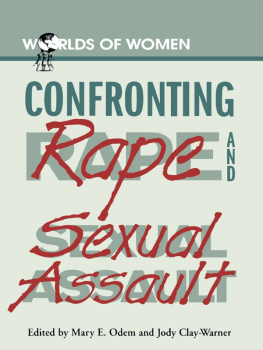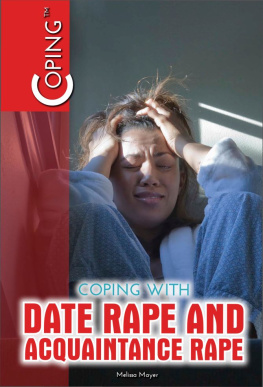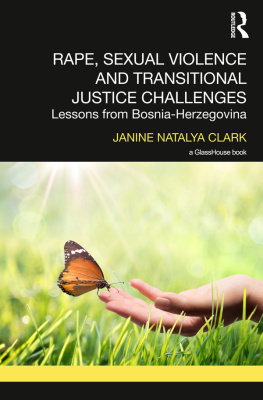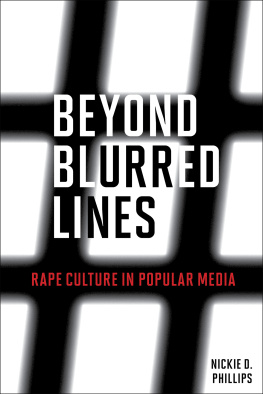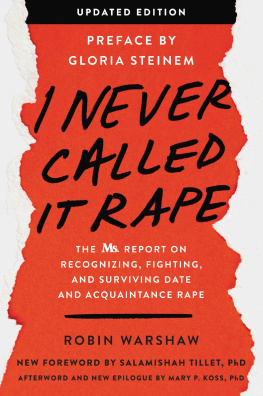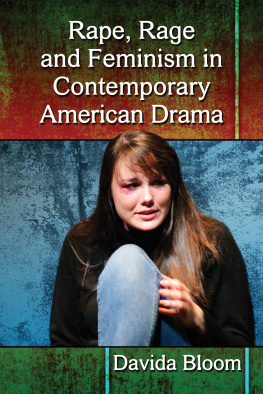Rape and Society
Crime & Society
Series Editor John Hagan, University of Toronto
EDITORIAL ADVISORY BOARD
John Braithwaite, Robert J. Bursik, Kathleen Daly,
Malcolm M. Feeley, Jack Katz, Martha A. Myers,
Robert J. Sampson, and Wesley G. Skogan
Rape and Society: Readings on the Problem of Sexual Assault,
edited by Patricia Searles and Ronald J. Berger
Alternatives to Imprisonment: Intentions and Reality,
Ulla V. Bondeson
Inequality, Crime, and Social Control, edited by
George S. Bridges and Martha A. Myers
FORTHCOMING
Poverty, Ethnicity, and Violent Crime,
James F. Short
Great Pretenders: A Study of Property Offenders,
Neal Shover
Youth and Social Justice: Toward the Twenty-first Century,
Nanette J. Davis and Suzanne E. Hatty
Crime, Justice, and Revolution in Eastern Europe,
Joachim J. Savelsbert
Crime, Justice, and Public Opinion,
Julian Roberts and Loretta Stalans
The White-Collar Offender, Michael Benson
and Francis T. Cullen
Rape and Society
Readings on the Problem of Sexual Assault
edited by
Patricia Searles
and Ronald J. Berger
University of Wisconsin-Whitewater
Crime & Society
First published 1995 by Westview Press
Published 2018 by Routledge
711 Third Avenue, New York, NY 10017, USA
2 Park Square, Milton Park, Abingdon, Oxon OX14 4RN
Routledge is an imprint of the Taylor & Francis Group, an informa business
Copyright 1995 Taylor & Francis
All rights reserved. No part of this book may be reprinted or reproduced or utilised in any form or by any electronic, mechanical, or other means, now known or hereafter invented, including photocopying and recording, or in any information storage or retrieval system, without permission in writing from the publishers.
Notice:
Product or corporate names may be trademarks or registered trademarks, and are used only for identification and explanation without intent to infringe.
Library of Congress Cataloging-in-Publication Data
Rape and society : readings on the problem of sexual assault / edited by Patricia Searles and Ronald J. Berger.
p. cm.(Crime & society)
Includes bibliographical references.
ISBN 0-8133-8823-6.ISBN 0-8133-8824-4 (pbk.)
1. Rape. 2. Sex crimes. I. Searles, Patricia. II. Berger, Ronald J. III. Series: Crime & society (Boulder, Colo.)
HV6558.R335 1995
364.1'532dc20
94-40409
CIP
ISBN 13: 978-0-8133-8824-3 (pbk)
Contents
PART ONE
FEMINIST FOUNDATIONS FOR THE STUDY OF RAPE AND SOCIETY
, Marge Piercy
, Diana E.H. Russell
, Stevi Jackson
, Catharine A. MacKinnon
, Mary P. Koss
PART TWO
WHY MEN RAPE
, Timothy Beneke
, Diana Scully and Joseph Marolla
, Judith Lewis Herman
, Catharine A. MacKinnon
PART THREE
VARIETIES OF RAPE AND SEXUAL ASSAULT
, Ellen Bass
, Maggie Hoyal
, Diana E.H. Russell
, Patricia Yancey Martin and Robert A. Hummer
, David Finkelhor and Kersti Yllo
, Jane Caputi
, Susan Brownmiller
, Nina Kadi
, Leslie A. Donovan
PART FOUR
RAPE AND THE LEGAL SYSTEM
, Susan Estrich
, Timothy Beneke
, Lisa Frohmann
, Jennifer Wriggins
, Ronald J. Berger, Patricia Searles, and W. Lawrence Neuman
PART FIVE
SURVIVING AND PREVENTING RAPE
, Ann Wolbert Burgess
, Christina Glendenning
, Fred Pelka
, Gail Groves
, Ellen Bass
THE CONTEMPORARY WOMEN'S MOVEMENT emerged from the general social discontent and protests of the 1960s to become a major political force in the United States. Margarita Papandreou (i988:xii) described the women's movement as "a loosely knit federation of women's organizations, working in resistance to humiliation, inequality, and injustice." One major focus of this movement has been the problem of violence against women, which includes several conceptually distinct yet overlapping concerns, including rape, incest, battering, sexual harassment, pornography, sexual slavery, and sexual murder.
There has been a virtual explosion of books and articles on violence against women, many of them written from a feminist perspective. Rape was the first such subject to receive extensive examination. Beginning with Susan Griffin's classic 1971 article, "Rape: The All-American Crime," and books by Susan Brownmpler ( Against Our Will, 1975), Diana Russell ( The Politics of Rape, 1975), Lorenne Clark and Debra Lewis ( Rape: The Price of Coercive Sexuality, 1977). Lynda Lytle Holmstrom and Ann Wolbert Burgess ( The Victim of Rape: Institutional Reactions, 1978), and Susan Griffin ( Rape: The Power of Consciousness, 1979), rape became the point of departure for an ongoing investigation of the subordination of women and of their experiences of sexual victimization. These works, along with the consciousness-raising movement of the 1970s, enabled women to move "from the discovery that sexual assault was not just an individual and unique experience to the realization that rape, as an issue, was a means of analyzing the psychological and political structures of oppression in our society" (New York Radical Feminists 1974:3).
Since the 1980s, incest, battery, and pornography have come to the forefront of investigators' concerns, and feminist scholars have increasingly analyzed the interrelationship among the various forms of sexual coercion. This book returns to the original focus on rape and falls within the feminist tradition of examining "rape as a paradigm for sexism in society" (Bart 1979). Although the book highlights rape, we have selected articles to show the interconnections among the many forms of violence against women. Hence selections on sexual abuse, incest, battery, pornography, and sexual murder are also included. Represented as well are the experiences of women of diverse backgrounds and lifestyles.
We attempt to provide a comprehensive treatment of the problem of sexual assault by drawing from writers and researchers across a range of social and behavioral sciences and the humanities. We believe this interdisciplinary anthology will be an important resource for academics and professionals who work in the area of sexual assault as well as a valuable text for undergraduate and graduate courses in women's studies, psychology, sociology, and criminology. The readings are drawn from scholarly journals, books, anthologies, and magazines. The selections provide a range of orientations to the topic: theoretical, empirical, literary, and experiential. The academic articles, although sophisticated in theory and method, remain accessible to students and provide excellent vehicles for instructors who wish to demonstrate the value of incisive analyses and carefully designed research. The literary and experiential pieces, which are both moving and thought provoking, sensitize readers to the personal and emotional dimensions of the problem and impress upon them the beauty and power of the written word. From our own teaching experience, we know that these readings are especially effective in provoking and encouraging classroom discussion.


